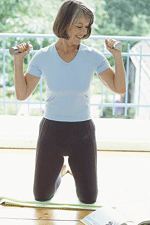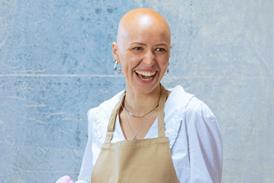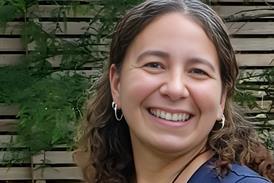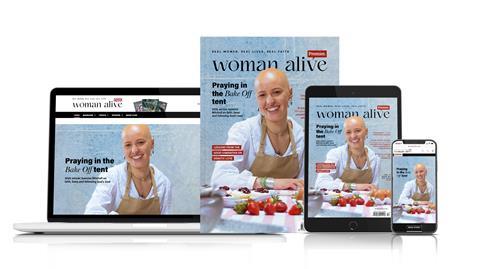
Give yourself a Health MOT!
Whatever your age, there are things you can do to improve your general well-being. Joanne Appleton has a decade by decade guide
Four things to do whatever your age
Eat a healthy diet
God has given us a huge variety of foods containing natural disease-busting elements – but highly processed junk food full of sugar, salt and fat aren’t on his menu!
Eating at least five portions of fruit and vegetables a day will increase our intake of fibre, vitamins and minerals – all of which help prevent disease. Increasing the amount of fish, chicken, beans or dairy products also helps.
Action: Try snacking on dried fruit, a carrot stick or banana, or drink fruit juice rather than a fizzy drink. For lunches: Make your own sandwiches, adding lettuce or tomato to the filling or simple vegetable soups with beans or lentils. Keep a bottle of water beside you while you work, so you can drink regularly.
Exercise regularly
Aerobic exercise, where we feel slightly out of breath, is vital for the health of our heart, lungs and circulation, as well as making us feel good. A century ago, you would have walked or cycled several miles a day just to get to the shops, and housework would have been much more physically demanding. Today, it’s more of a challenge to fit in the recommended 30 minutes of aerobic exercise five times a week.
Action: Try parking further from the shops or your workplace and walk the rest of the way. Join an exercise class – it’s a good way to meet people as well.
Avoid smoking
Smoking is one of the biggest causes of ill health, greatly increasing the risk of arterial disease such as heart attack and stroke, as well as some forms of cancer.
Action: If you do smoke, talk to your GP about ways to stop. Even if you don’t smoke, there is some evidence that passive smoking can still be harmful, so avoid smoky atmospheres as much as possible. The good news is that legislation has been proposed to ban smoking in public places across the UK by 2008.
Check your breasts
While breast cancer is most commonly diagnosed in women over 50, we still need to check our breasts for lumps as the disease can occur at any age. A good time to examine them is just after a period, when breasts are softest.
Action: Breakthrough Cancer Charity’s message is: Touch your breasts. Feel for anything unusual. Look for changes. Be aware of their shape and texture. Check anything unusual with your doctor. Chat with your friends if you are worried. Talk to your GP if close family members developed the disease before the menopause.
20’s and 30’s
Your health issues:
* Fertility Our fertility is highest in our mid-twenties and starts to decline from around the age of 33. By our late 30’s, the number and quality of eggs is reduced. It becomes harder to conceive and there is a higher risk of miscarriage and congenital problems such as Down’s syndrome.
If you have been trying unsuccessfully for a year to conceive, or nine months if you are over 35, it is worth talking to your GP to explore the options. You and your partner may undergo tests to discover why you are having difficulty conceiving, and you will be talked through the various treatments available.
Tests you should have
* Cervical Smear This is carried out every three to five years from the age of 25 if you have ever been sexually active. The test involves taking a sample of the cells from the neck of the womb (cervix) and checking for abnormal cells that could in time become cancerous. If abnormal cells are found, laser treatment or cryotherapy will help prevent the squamous cell type of cervical cancer from developing.
Frequency of testing depends on where you live. In Avon for example, you are tested every three years until your late 40’s and every five years thereafter.
* Cholesterol High cholesterol, in conjunction with other risk factors such as being overweight, smoking or a family history, can increase your risk of heart disease – still the leading cause of death in the UK.
Get your cholesterol checked if you have a family history of heart disease, especially if a parent suffered a stroke or heart attack before the age of 65. This involves a simple blood test taken after a 12 hour fast. There are two types of cholesterol in the blood, the ‘healthy’ high density lipoprotein (HDL) and the ‘unhealthy’ low density lipoprotein. (LDL) The important thing is the ratio between the two, and the blood test looks for the relative values of each in your blood.
Treatment includes lifestyle changes such as exercise and modifying your diet, and possibly the prescription of statins which help to lower the unhealthy cholesterol and raise the healthy cholesterol.
40’s
Your health issues
* Bone strength Osteoporosis becomes more common in women after the menopause, however younger women can also be affected. We are more at risk of it if we have a family history of the condition, have gone through an early menopause or hysterectomy including removal of ovaries, or had the prolonged use of steroids.
Weight-bearing exercise is one of the most important ways to help prevent osteoporosis – so walking or aerobics helps. Make sure your diet is rich in calcium from dairy produces, leafy vegetables, baked beans, dried fruit. Vitamin D helps the body to absorb sunlight, so get outside for some time each day, or if this is impossible, take a Vitamin D supplement.
* Back pain According to the charity Backcare, around 41% of women between 45 and 64 will experience back pain. There are many causes – some due to conditions such as osteoporosis or arthritis, others due to lifting incorrectly or poor posture while driving or sitting.
We can help prevent back pain by lifting properly: keep objects close to the body and bend hips and knees to lift. Use the correct height of chair and desk if you work in an office, and make sure your car seat is properly adjusted when you drive.
If you do get a sore back, take painkillers and continue with normal activities as much as possible. See your GP after a week if the pain is no better however pin and needles in your legs or difficulty going to the toilet require more urgent attention.
Tests you should have
Urine check Type 2, or non-insulin dependant diabetes, is most common in those over 40, or those who are overweight. Symptoms include: needing to go to toilet more often, tiredness, increased thirst, and weight loss.
It’s a good idea to get your urine tested for raised blood sugar levels once you are over 50. However, if you have a family history of diabetes, it is worth asking your GP to check it now as you can have diabetes for some time before the symptoms appear.
50’s
Your health issues:
* Menopause/ HRT
For most of us, sometime between the ages of 45 and 55, the levels of the hormones oestrogen and progesterone in our body drops, and our periods stop. This is known as the menopause or ‘the change’. The menopause can last for some time, and the decreasing levels of hormones cause other symptoms. These most commonly include: night sweats, inablility to sleep, hot flushes and vaginal dryness.
The most common treatment is Hormone Replacement therapy (HRT) where you are treated with combination of progesterone and oestrogen. This controls the symptoms, but some forms mean you continue to have periods. There is also thought to be an increased risk of heart disease, stroke or breast cancer if you stay on HRT for long periods of time.
Some women prefer herbal or homeopathic remedies for menopausal symptoms, however if you do so, it is important to inform your GP.
Tests you should have:
* Breast screening Over 80% of breast cancers occur in women over 50, and national guidelines require women between 50 and 70 to have a mammogram every three years. This is a type of X-ray looking at the breast tissue and it can detect changes in the breast tissue that are too small to be felt.
* Blood pressure This should be checked more regularly, as high blood pressure is a factor in the development of heart disease. You have high blood pressure when the reading is consistently more than 140/90mmHg. If your blood pressure readings are raised, your GP will discuss a variety of treatment options with you, such as lifestyle changes and possibly medication.
* Cholesterol It’s a good idea to have your cholesterol (also a factor in heart disease) and blood sugar levels checked at same time as your blood pressure.
60+
Your health issue
* Heart disease This becomes more common as you get older. A common symptom of heart disease is angina: a crushing chest pain that may radiate down left arm. In severe cases this can occur at rest, but often happens after exertion. Heart disease also puts you at higher risk of a heart attack or stroke. Risk factors for heart disease include high cholesterol, diabetes, raised blood pressure, smoking or a family history of the condition. You can help prevent it by keeping your cholesterol levels low, exercise, healthy diet, and treatment includes aspirin, Beta blockers and other medications depending on your condition.
* Arthritis Again this becomes more common in the 60+age group. Maintaining a healthy weight and keeping moving are important factors in preventing and managing the condition. You may be prescribed a variety of painkillers, and encouraged to exercise as much as you can within the level of pain.
Tests you should have
* Health check People over 75 can request an annual health check, and some health authorities also offer testing for over 60’s on request. They may also provide a medication check where you have the opportunity to discuss any medication you may be taking.
* Sight tests Over 60’s are eligible for free NHS sight tests every two years. It should include testing for glaucoma, a condition more common in later life, or people of Afro-Caribbean origin.






























